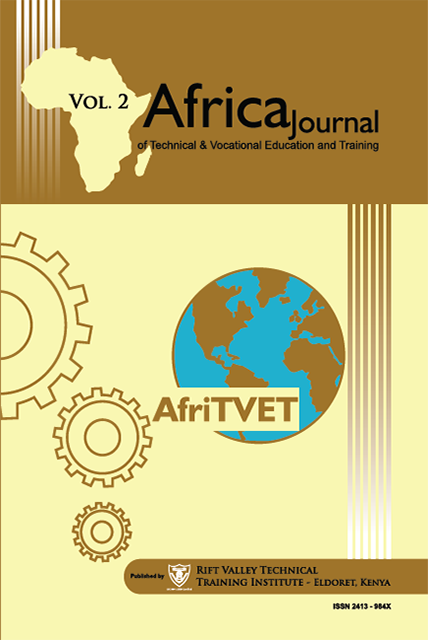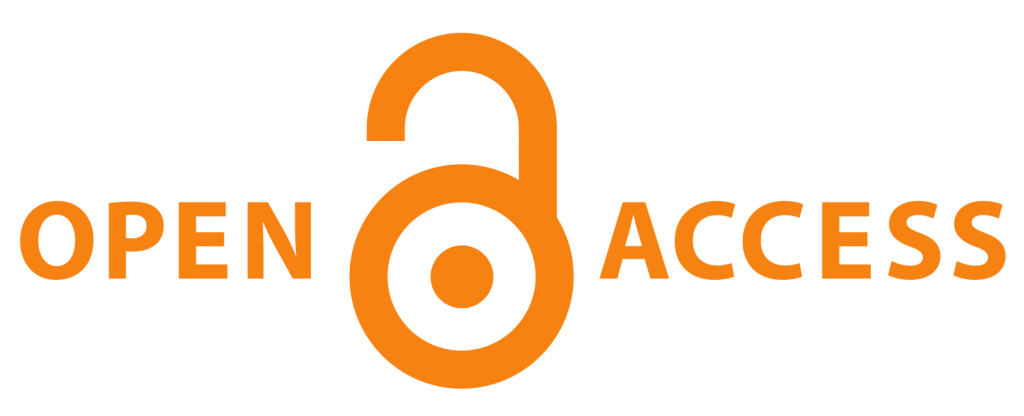Imparting Entrepreneurial Skills to the Disadvantaged Citizen Groups through Adopting Flexible and Blended Skills: The Tanzanian Context
Keywords:
Disadvantaged citizen groups, entrepreneurship skills, FaBS
Abstract
When governments in many developing countries pay attention and efforts to lower poverty levels among their people, the disadvantaged citizen groups (DCGs) are among the groups that need special attention. This study focusses on a specific DCG of people/students who drop-out of various levels of education: primary schools, secondary schools, tertiary institutions and universities. As part of a big development project, this study develops a conceptual model with a view to building capabilities of the DCGs by imparting on them entrepreneurial hands-on business skills, facilitated through a flexible & blended skills (FaBs) model. The developed model comprises six elements with the main functionality of posing procedures to the DCGs to learn entrepreneurial skills through the FaB system, and engage with own businesses of preference. They include: (i) identifying the characteristics of the DCGs (ii) preparing institutional infrastructure, (iii) preparing online and practical courses, (iv) conducting online courses, (v) conducting the courses in the institution, and (vi) conducting industrial practical studies. While five elements are self-descriptive, element two, that is ‘preparing institutional infrastructure’ was decomposed further into five sub-elements as follows: (i) merging policies and strategies of the TVET institution against that of the nation, (ii) modifying the institutional curriculum, (iii) defining identifying buildings’ infrastructural spaces and uses, (iv) evaluating the institutional staff requirements in terms of knowledge categories, workloads and the additional loads that may be assigned from the FaBs model, and (v) mapping out institutional ICT’s infrastructural requirements to support FaBs studies. Translating the holistic model, it was argued that, if DCGs participate in the FaBs studies committedly; they would receive course instructions flexibly, gain both entrepreneurial theories and practical skills, thereby alleviating the prevailing poverty levels. The study also concluded that knowledge and skills gained by the DCGs will help them support themselves, their families as well as boost the national economy. The findings of the study have utility in many other countries.Article Views and Downloands Counter
Download data is not yet available.
References
Asian Development, Bank [ADB]. (2009). Legal empowerment for women and disadvantaged groups. Final Report, 6 ADB Avenue, Nandaluyong City, Philippines.
Barnes, M., Green, R. & Natcen, A. R. (2011). Understanding vulnerable young people: Analysis from the longitudinal study of young people in England. Research report DFE=RR 118, UK: Department for Education.
Barrett, R. (2010). Disadvantaged groups in the labour market, an article of the office for national statistics, economic & labour groups in librarianship. International Research Journal, Global Journal of Management and Business Research, Vol. 12, Issue 19, Version 1.0. USA.
Brennan, J. Little, B. and Locke, W. (2006). Higher education’s effects on disadvantaged groups and communities, Report on an ESRC Network on cross regional perspectives on the transformative impact of higher education on disadvantaged groups and communities, center for higher education research and information. London.
Fairlie, R. W. (2005) Entrepreneurship among disadvantaged groups: An analysis of the dynamics of self-employment by gender, race, and education, Santa Cruz: University of California, Department of Economics.
Kimambo, Z. C. M. (2005). Simulating small and medium enterprises development for poverty reduction through business and technology incubation. Proceedings of the 3rd Annual Engineering Day, 18th – 19th, March, Dar es salaam.
Mayer, S. E. (2003). What is a “Disadvantaged group”? Effective communities in
project Minneapolis, Sourced from Rainbow Research. USA. Retrieved from www.RainbowResearch.org
NECTA Results. (2013). Matokeo ya kidato cha nne 2013 (National form four results). Retrieved from http://www.mpekuzihuru.com/2014/02/matokeo- ya-kidato-cha-nne-2013- 2014.html
NECTA Results. (2013). Matokeo darasa la saba hadharani (National standard seven results). Retrieved from http://www.mwananchi.co.tz/habari/Kitaifa/-
/1597296/1648956/-/11pwo0v/-/index.html
NECTA Results. (2013). Matokeo ya kidato sita 2013, (National form six results.) Retrieved from http://www.tanzaniatoday.co.tz/news/matokeo-ya-kidato-cha- nne-yatangazwa-sekondari-ya-kaizirege-yaongozalist-kamili-iko-hapa
Ozolina, L. U. (2011). Technology use for collaboration in blended learning. Problems of Education in the 21st Century, Vol. 33. Latvia: Liepaja University.
Osorio, M., Percia, M. & Battista F. D. (2014). Gender inequalities in rural employment in Tanzania mainland, an overview: Report of the food and agriculture organization of the United Nations. Fome, 2015.
Richardson, A. M. (2012). Flexible and blended learning in TVET, Presentation at the
UNESCO 3rd World Congress on TVET, 12 – 14 May, Shanghai, China.
Santos, S. C., Cacentano,A. & Curral, L. (2013). Psychosocial aspects of entrepreneurship potential. Journal of Small Business and Entrepreneurship. Portugal: Instituto Universitario de Lisboa.
Schadauer, A., Wiesinger, J. & Oztaysi, B.,Turan, N. & Metin Yıldırım, M. (2014).
Identification of disadvantaged groups in Vienna and Istanbul, Joint programming initiative. Urban Europe. Retrieved from www.withoutbarriers.org
State Council of Higher Education for Virginia, (SCHEV). (2004). Space utilization and comparison report. Virginia.
Unegbu, V. E. (2012). Expansion and redefinition of disadvantaged user groups in librarianship. Global Journal of Management and Business Research, Vol. 12, Issue 19, Version 1.0
United Republic of Tanzania, (URT). (1996). The Technical education and training policy in Tanzania. Dar es Salaam, Tanzania.
Barnes, M., Green, R. & Natcen, A. R. (2011). Understanding vulnerable young people: Analysis from the longitudinal study of young people in England. Research report DFE=RR 118, UK: Department for Education.
Barrett, R. (2010). Disadvantaged groups in the labour market, an article of the office for national statistics, economic & labour groups in librarianship. International Research Journal, Global Journal of Management and Business Research, Vol. 12, Issue 19, Version 1.0. USA.
Brennan, J. Little, B. and Locke, W. (2006). Higher education’s effects on disadvantaged groups and communities, Report on an ESRC Network on cross regional perspectives on the transformative impact of higher education on disadvantaged groups and communities, center for higher education research and information. London.
Fairlie, R. W. (2005) Entrepreneurship among disadvantaged groups: An analysis of the dynamics of self-employment by gender, race, and education, Santa Cruz: University of California, Department of Economics.
Kimambo, Z. C. M. (2005). Simulating small and medium enterprises development for poverty reduction through business and technology incubation. Proceedings of the 3rd Annual Engineering Day, 18th – 19th, March, Dar es salaam.
Mayer, S. E. (2003). What is a “Disadvantaged group”? Effective communities in
project Minneapolis, Sourced from Rainbow Research. USA. Retrieved from www.RainbowResearch.org
NECTA Results. (2013). Matokeo ya kidato cha nne 2013 (National form four results). Retrieved from http://www.mpekuzihuru.com/2014/02/matokeo- ya-kidato-cha-nne-2013- 2014.html
NECTA Results. (2013). Matokeo darasa la saba hadharani (National standard seven results). Retrieved from http://www.mwananchi.co.tz/habari/Kitaifa/-
/1597296/1648956/-/11pwo0v/-/index.html
NECTA Results. (2013). Matokeo ya kidato sita 2013, (National form six results.) Retrieved from http://www.tanzaniatoday.co.tz/news/matokeo-ya-kidato-cha- nne-yatangazwa-sekondari-ya-kaizirege-yaongozalist-kamili-iko-hapa
Ozolina, L. U. (2011). Technology use for collaboration in blended learning. Problems of Education in the 21st Century, Vol. 33. Latvia: Liepaja University.
Osorio, M., Percia, M. & Battista F. D. (2014). Gender inequalities in rural employment in Tanzania mainland, an overview: Report of the food and agriculture organization of the United Nations. Fome, 2015.
Richardson, A. M. (2012). Flexible and blended learning in TVET, Presentation at the
UNESCO 3rd World Congress on TVET, 12 – 14 May, Shanghai, China.
Santos, S. C., Cacentano,A. & Curral, L. (2013). Psychosocial aspects of entrepreneurship potential. Journal of Small Business and Entrepreneurship. Portugal: Instituto Universitario de Lisboa.
Schadauer, A., Wiesinger, J. & Oztaysi, B.,Turan, N. & Metin Yıldırım, M. (2014).
Identification of disadvantaged groups in Vienna and Istanbul, Joint programming initiative. Urban Europe. Retrieved from www.withoutbarriers.org
State Council of Higher Education for Virginia, (SCHEV). (2004). Space utilization and comparison report. Virginia.
Unegbu, V. E. (2012). Expansion and redefinition of disadvantaged user groups in librarianship. Global Journal of Management and Business Research, Vol. 12, Issue 19, Version 1.0
United Republic of Tanzania, (URT). (1996). The Technical education and training policy in Tanzania. Dar es Salaam, Tanzania.
Published
2017-10-01
How to Cite
Mwishwa, Y. (2017). Imparting Entrepreneurial Skills to the Disadvantaged Citizen Groups through Adopting Flexible and Blended Skills: The Tanzanian Context. Africa Journal of Technical and Vocational Education and Training, 2(1), 51-63. Retrieved from https://afritvet.org/index.php/Afritvet/article/view/36
Section
ACCESS AND INCLUSION IN EDUCATION AND TRAINING
Copyright Notice
Copyright of published articles is held by AfriTVET. No limitation will be placed on the personal freedom of authors to copy or to use in subsequent work, material contained in their papers. Please contact the Publisher for clarification if you are unsure of the use of copyright material. Apart from fair dealing for the purposes of research and private study, or criticism and or review, this publication may only be reproduced, stored or transmitted, in any form or by any means, with the prior permission in writing of the Publishers.



